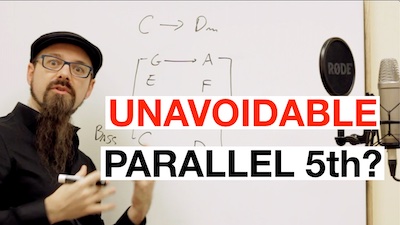Impossible Voice Leading - How Do We Avoid THIS?


I got this comment on one of my videos (turn images on):

(In case you can’t read it, it says: “Would it be possible to avoid parallel fifths when playing two adjacent chords one scale step apart while still trying to keep a voice leading. For me, it does not seem possible to do a I-ii, IV-V or bVii-i in invoice leading without using parallel fifths.”)
(If you have no idea what we are talking about, I explain everything in the video below… trust me, your music will be better for it)
First of all, that’s a great question!
Second, I can tell you that in most situations if you lead these two chords without parallel 5ths, they sound better. And even if you like the sound of parallel 5ths, it’s still good to have options.
But yes, at first sight it looks impossible to do. How do you avoid the parallel 5th here?
This is the same thing that I thought when I was learning harmony, so you if you too are stumped by this question you are in good company.
And then a friend showed me the trick to it… and it was so obvious.
… well of course it was obvious only AFTER they told me :-)
Isn’t this the case for so many brilliant thing? They are obvious in hindsight.
So you may react to this video as “OMG this is the most genius thing ever” or you may react as: “I don’t see why you make such a big deal out of it”.
Anyway, here’s how you do an apparently impossible thing in a very simple way. Watch the video here:
In this video we also answer:- Is C F# G a Lydian triad? And can you explain different triads like E locrian?
- Can this exercise improve my finger style more drastically than just practicing a finger style song?
- What century is the augmented sixth chord from? It sounds and functions like a dominant?
If instead you are more interested in parallel 5ths, then have a look at this:
And if you want to understand all of this on your guitar at a level when you don’t need to think about it anoymore because you JUST KNOW it, then take the Complete Chord Mastery guitar course and do all the exercises in there. Be ready to amaze yourself.
Did you find this video helpful? Do not miss the next Music Theory videos!
Subscribe to the MusicTheoryForGuitar YouTube channel by clicking the button below.